Comprehensive Report on Contract Law: Elements, Terms, and Liabilities
VerifiedAdded on 2020/02/03
|12
|3785
|407
Report
AI Summary
This report delves into the fundamental aspects of contract law, emphasizing its pivotal role in business relationships by defining the rights and obligations of involved parties. It begins by outlining the essential elements required for a valid contract, including offer, acceptance, consideration, and intention to create legal relations, with supporting case law such as Harvey v. Facey and Felthouse v. Bindley. The report then classifies contracts based on their validity (valid, void, voidable, illegal, and unenforceable), detailing the implications of each type. Furthermore, it analyzes the different types of contractual terms (express and implied) and their significance, including conditions, warranties, and exclusion clauses, referencing cases like Scammel v Ouston and Chapelton v. Barry. The report also examines scenarios involving offer vs. invitation to treat, the consequences of breach of contract terms, and the distinction between contractual and tortious liabilities, providing examples like Fisher v. Bell and British Transport Commission v. Gourley. Overall, the report provides a comprehensive overview of contract law principles and their practical applications.
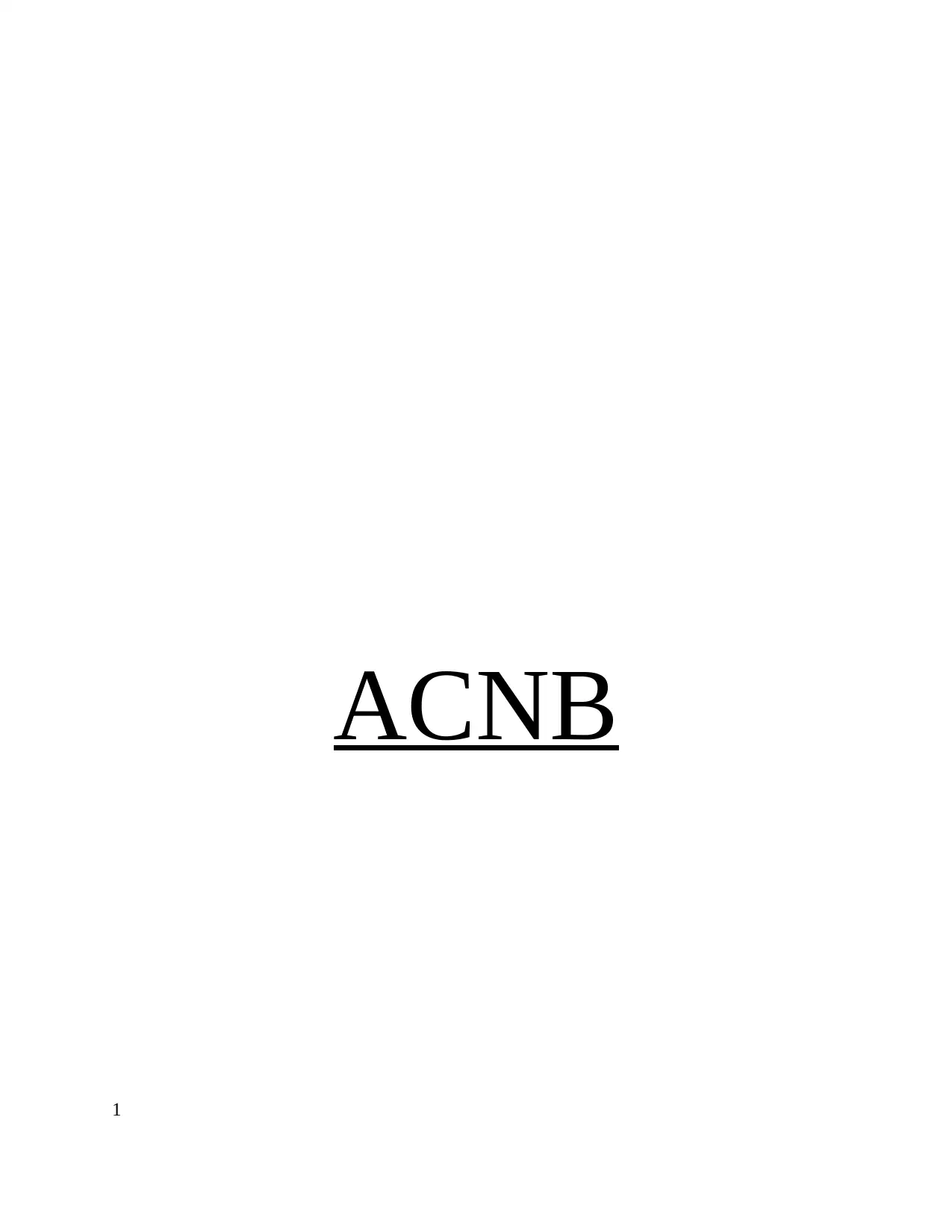
ACNB
1
1
Secure Best Marks with AI Grader
Need help grading? Try our AI Grader for instant feedback on your assignments.
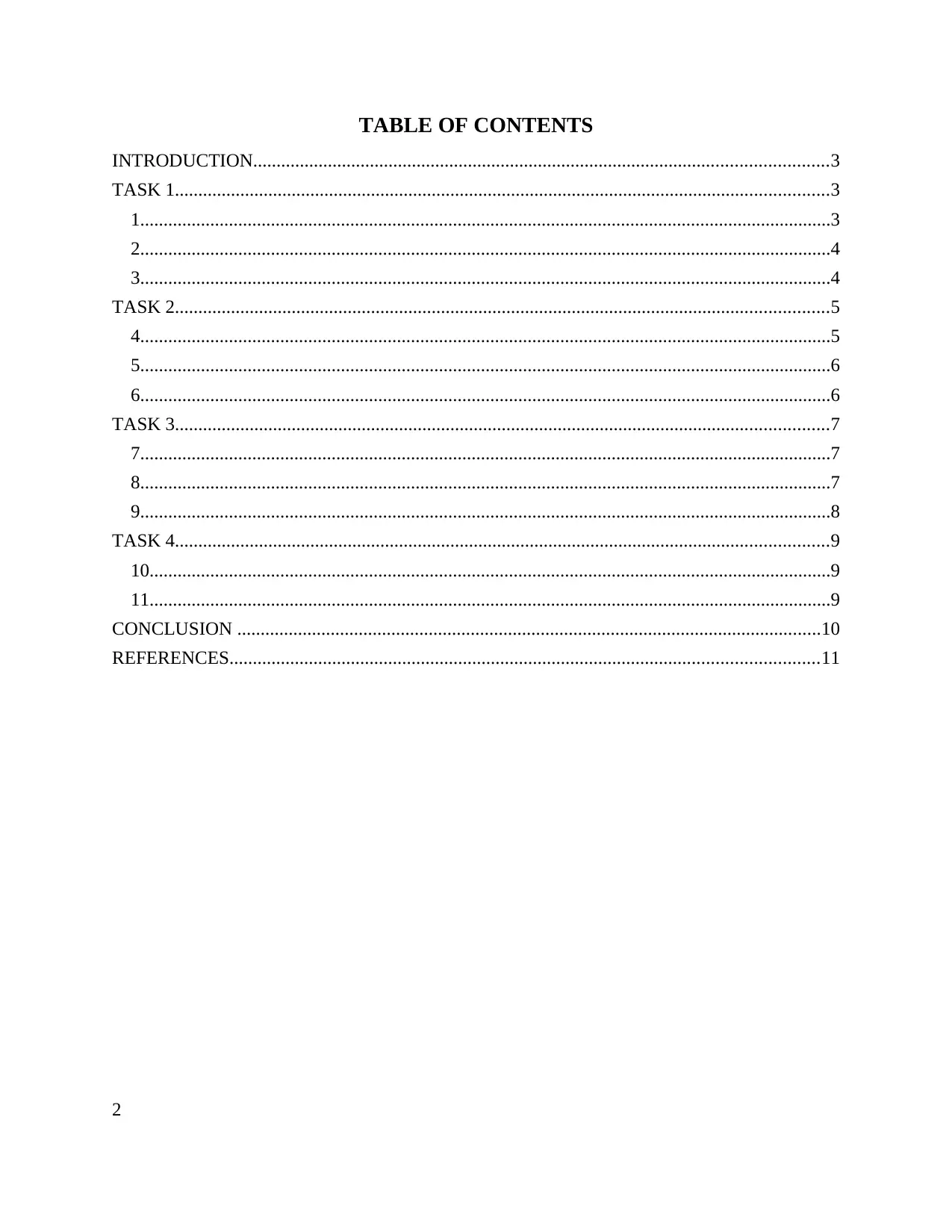
TABLE OF CONTENTS
INTRODUCTION...........................................................................................................................3
TASK 1............................................................................................................................................3
1....................................................................................................................................................3
2....................................................................................................................................................4
3....................................................................................................................................................4
TASK 2............................................................................................................................................5
4....................................................................................................................................................5
5....................................................................................................................................................6
6....................................................................................................................................................6
TASK 3............................................................................................................................................7
7....................................................................................................................................................7
8....................................................................................................................................................7
9....................................................................................................................................................8
TASK 4............................................................................................................................................9
10..................................................................................................................................................9
11..................................................................................................................................................9
CONCLUSION .............................................................................................................................10
REFERENCES..............................................................................................................................11
2
INTRODUCTION...........................................................................................................................3
TASK 1............................................................................................................................................3
1....................................................................................................................................................3
2....................................................................................................................................................4
3....................................................................................................................................................4
TASK 2............................................................................................................................................5
4....................................................................................................................................................5
5....................................................................................................................................................6
6....................................................................................................................................................6
TASK 3............................................................................................................................................7
7....................................................................................................................................................7
8....................................................................................................................................................7
9....................................................................................................................................................8
TASK 4............................................................................................................................................9
10..................................................................................................................................................9
11..................................................................................................................................................9
CONCLUSION .............................................................................................................................10
REFERENCES..............................................................................................................................11
2
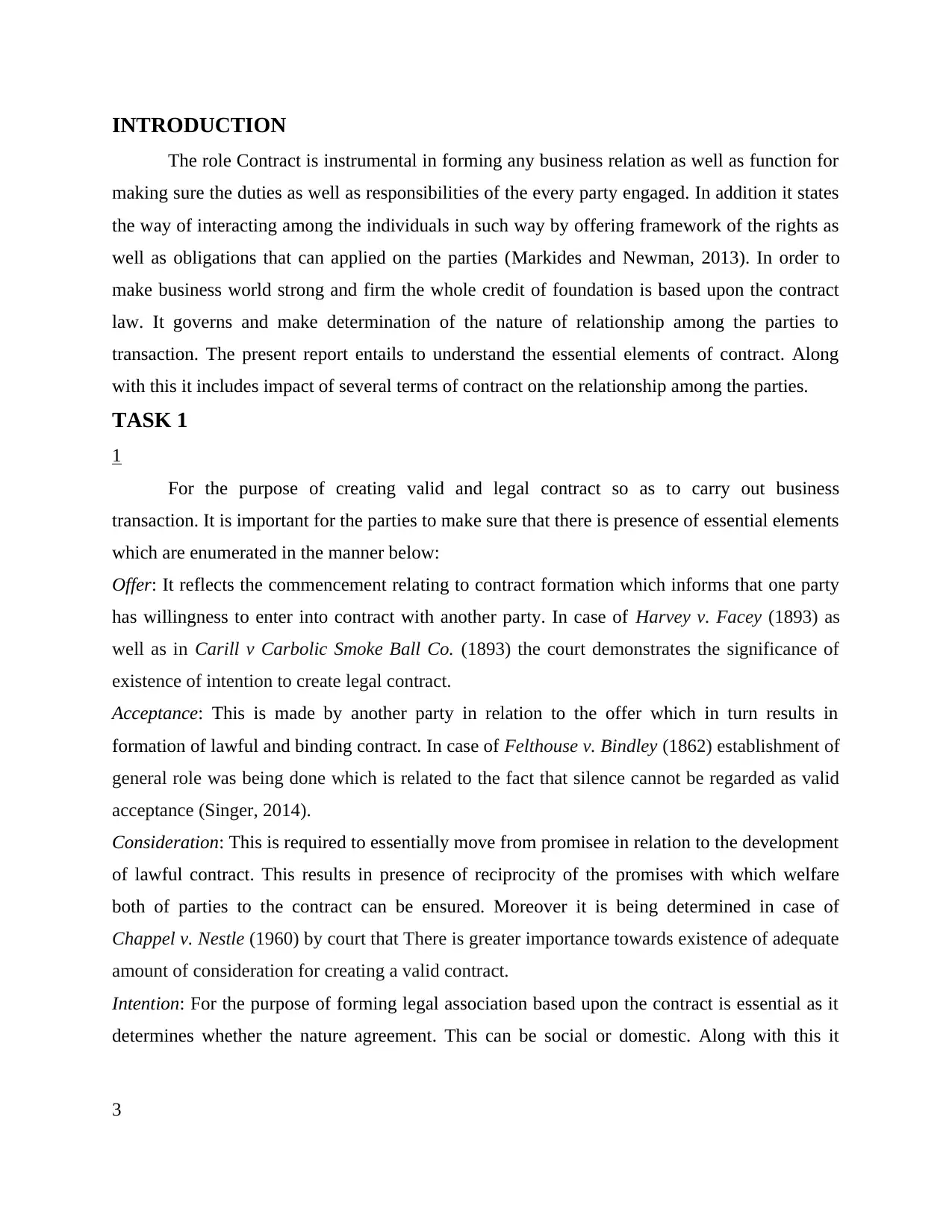
INTRODUCTION
The role Contract is instrumental in forming any business relation as well as function for
making sure the duties as well as responsibilities of the every party engaged. In addition it states
the way of interacting among the individuals in such way by offering framework of the rights as
well as obligations that can applied on the parties (Markides and Newman, 2013). In order to
make business world strong and firm the whole credit of foundation is based upon the contract
law. It governs and make determination of the nature of relationship among the parties to
transaction. The present report entails to understand the essential elements of contract. Along
with this it includes impact of several terms of contract on the relationship among the parties.
TASK 1
1
For the purpose of creating valid and legal contract so as to carry out business
transaction. It is important for the parties to make sure that there is presence of essential elements
which are enumerated in the manner below:
Offer: It reflects the commencement relating to contract formation which informs that one party
has willingness to enter into contract with another party. In case of Harvey v. Facey (1893) as
well as in Carill v Carbolic Smoke Ball Co. (1893) the court demonstrates the significance of
existence of intention to create legal contract.
Acceptance: This is made by another party in relation to the offer which in turn results in
formation of lawful and binding contract. In case of Felthouse v. Bindley (1862) establishment of
general role was being done which is related to the fact that silence cannot be regarded as valid
acceptance (Singer, 2014).
Consideration: This is required to essentially move from promisee in relation to the development
of lawful contract. This results in presence of reciprocity of the promises with which welfare
both of parties to the contract can be ensured. Moreover it is being determined in case of
Chappel v. Nestle (1960) by court that There is greater importance towards existence of adequate
amount of consideration for creating a valid contract.
Intention: For the purpose of forming legal association based upon the contract is essential as it
determines whether the nature agreement. This can be social or domestic. Along with this it
3
The role Contract is instrumental in forming any business relation as well as function for
making sure the duties as well as responsibilities of the every party engaged. In addition it states
the way of interacting among the individuals in such way by offering framework of the rights as
well as obligations that can applied on the parties (Markides and Newman, 2013). In order to
make business world strong and firm the whole credit of foundation is based upon the contract
law. It governs and make determination of the nature of relationship among the parties to
transaction. The present report entails to understand the essential elements of contract. Along
with this it includes impact of several terms of contract on the relationship among the parties.
TASK 1
1
For the purpose of creating valid and legal contract so as to carry out business
transaction. It is important for the parties to make sure that there is presence of essential elements
which are enumerated in the manner below:
Offer: It reflects the commencement relating to contract formation which informs that one party
has willingness to enter into contract with another party. In case of Harvey v. Facey (1893) as
well as in Carill v Carbolic Smoke Ball Co. (1893) the court demonstrates the significance of
existence of intention to create legal contract.
Acceptance: This is made by another party in relation to the offer which in turn results in
formation of lawful and binding contract. In case of Felthouse v. Bindley (1862) establishment of
general role was being done which is related to the fact that silence cannot be regarded as valid
acceptance (Singer, 2014).
Consideration: This is required to essentially move from promisee in relation to the development
of lawful contract. This results in presence of reciprocity of the promises with which welfare
both of parties to the contract can be ensured. Moreover it is being determined in case of
Chappel v. Nestle (1960) by court that There is greater importance towards existence of adequate
amount of consideration for creating a valid contract.
Intention: For the purpose of forming legal association based upon the contract is essential as it
determines whether the nature agreement. This can be social or domestic. Along with this it
3
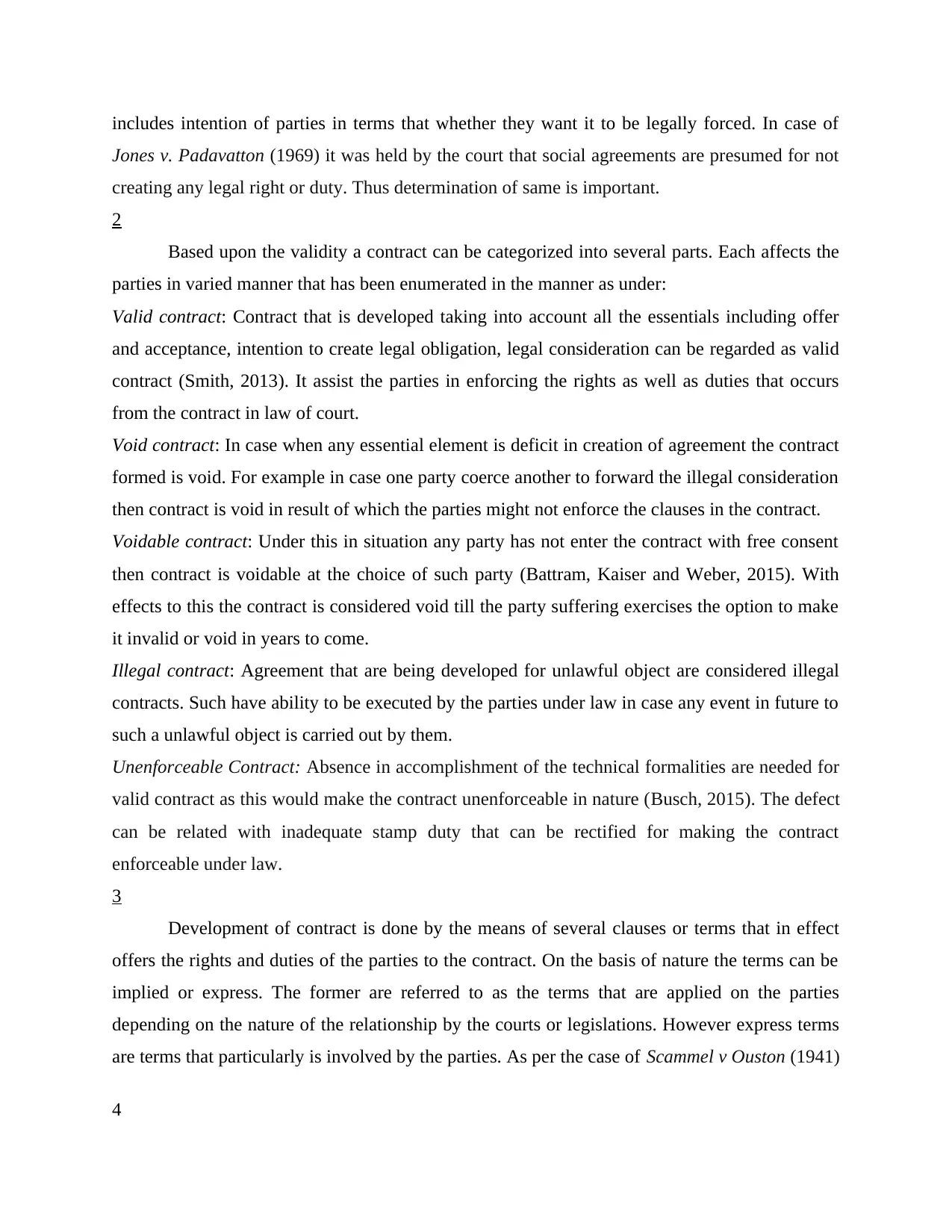
includes intention of parties in terms that whether they want it to be legally forced. In case of
Jones v. Padavatton (1969) it was held by the court that social agreements are presumed for not
creating any legal right or duty. Thus determination of same is important.
2
Based upon the validity a contract can be categorized into several parts. Each affects the
parties in varied manner that has been enumerated in the manner as under:
Valid contract: Contract that is developed taking into account all the essentials including offer
and acceptance, intention to create legal obligation, legal consideration can be regarded as valid
contract (Smith, 2013). It assist the parties in enforcing the rights as well as duties that occurs
from the contract in law of court.
Void contract: In case when any essential element is deficit in creation of agreement the contract
formed is void. For example in case one party coerce another to forward the illegal consideration
then contract is void in result of which the parties might not enforce the clauses in the contract.
Voidable contract: Under this in situation any party has not enter the contract with free consent
then contract is voidable at the choice of such party (Battram, Kaiser and Weber, 2015). With
effects to this the contract is considered void till the party suffering exercises the option to make
it invalid or void in years to come.
Illegal contract: Agreement that are being developed for unlawful object are considered illegal
contracts. Such have ability to be executed by the parties under law in case any event in future to
such a unlawful object is carried out by them.
Unenforceable Contract: Absence in accomplishment of the technical formalities are needed for
valid contract as this would make the contract unenforceable in nature (Busch, 2015). The defect
can be related with inadequate stamp duty that can be rectified for making the contract
enforceable under law.
3
Development of contract is done by the means of several clauses or terms that in effect
offers the rights and duties of the parties to the contract. On the basis of nature the terms can be
implied or express. The former are referred to as the terms that are applied on the parties
depending on the nature of the relationship by the courts or legislations. However express terms
are terms that particularly is involved by the parties. As per the case of Scammel v Ouston (1941)
4
Jones v. Padavatton (1969) it was held by the court that social agreements are presumed for not
creating any legal right or duty. Thus determination of same is important.
2
Based upon the validity a contract can be categorized into several parts. Each affects the
parties in varied manner that has been enumerated in the manner as under:
Valid contract: Contract that is developed taking into account all the essentials including offer
and acceptance, intention to create legal obligation, legal consideration can be regarded as valid
contract (Smith, 2013). It assist the parties in enforcing the rights as well as duties that occurs
from the contract in law of court.
Void contract: In case when any essential element is deficit in creation of agreement the contract
formed is void. For example in case one party coerce another to forward the illegal consideration
then contract is void in result of which the parties might not enforce the clauses in the contract.
Voidable contract: Under this in situation any party has not enter the contract with free consent
then contract is voidable at the choice of such party (Battram, Kaiser and Weber, 2015). With
effects to this the contract is considered void till the party suffering exercises the option to make
it invalid or void in years to come.
Illegal contract: Agreement that are being developed for unlawful object are considered illegal
contracts. Such have ability to be executed by the parties under law in case any event in future to
such a unlawful object is carried out by them.
Unenforceable Contract: Absence in accomplishment of the technical formalities are needed for
valid contract as this would make the contract unenforceable in nature (Busch, 2015). The defect
can be related with inadequate stamp duty that can be rectified for making the contract
enforceable under law.
3
Development of contract is done by the means of several clauses or terms that in effect
offers the rights and duties of the parties to the contract. On the basis of nature the terms can be
implied or express. The former are referred to as the terms that are applied on the parties
depending on the nature of the relationship by the courts or legislations. However express terms
are terms that particularly is involved by the parties. As per the case of Scammel v Ouston (1941)
4
Secure Best Marks with AI Grader
Need help grading? Try our AI Grader for instant feedback on your assignments.
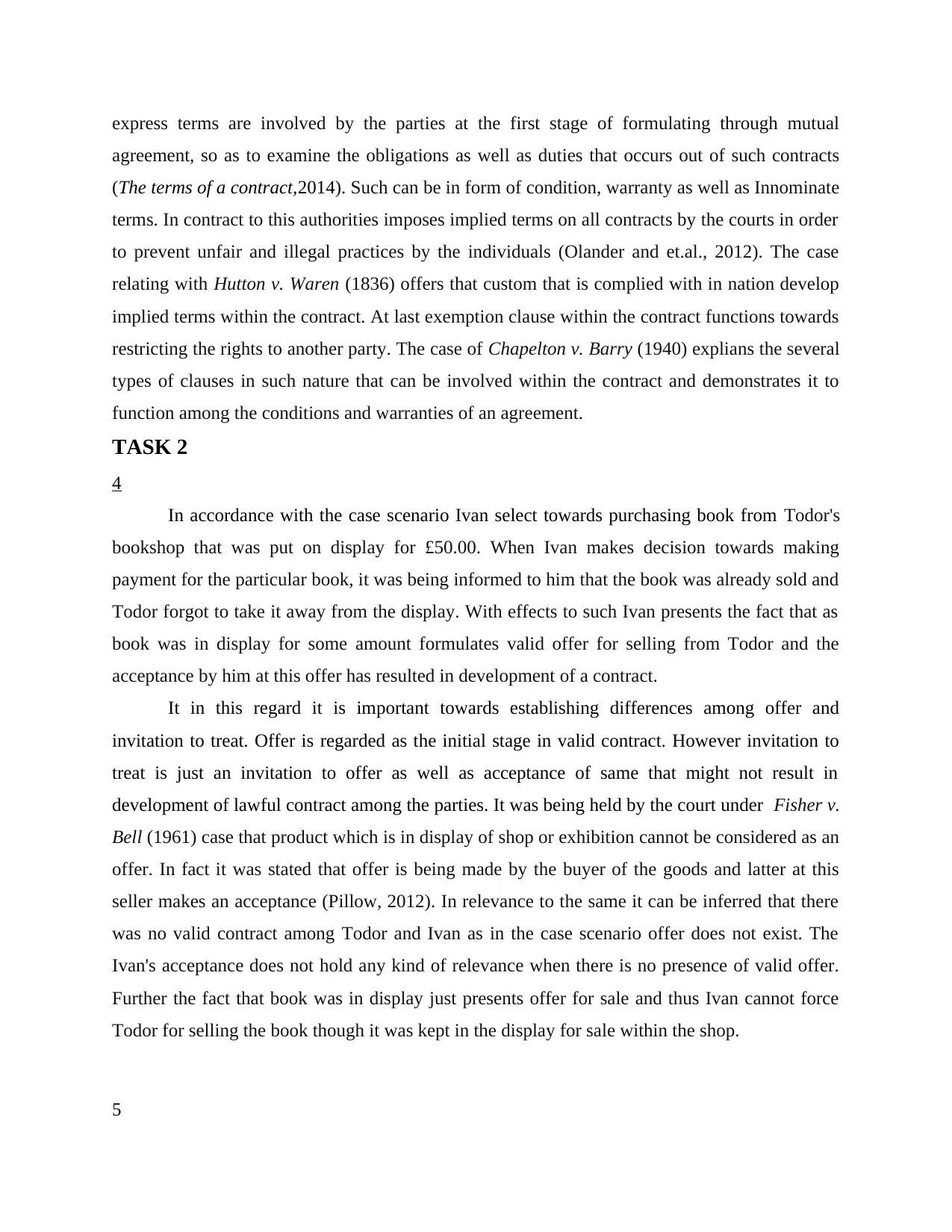
express terms are involved by the parties at the first stage of formulating through mutual
agreement, so as to examine the obligations as well as duties that occurs out of such contracts
(The terms of a contract,2014). Such can be in form of condition, warranty as well as Innominate
terms. In contract to this authorities imposes implied terms on all contracts by the courts in order
to prevent unfair and illegal practices by the individuals (Olander and et.al., 2012). The case
relating with Hutton v. Waren (1836) offers that custom that is complied with in nation develop
implied terms within the contract. At last exemption clause within the contract functions towards
restricting the rights to another party. The case of Chapelton v. Barry (1940) explians the several
types of clauses in such nature that can be involved within the contract and demonstrates it to
function among the conditions and warranties of an agreement.
TASK 2
4
In accordance with the case scenario Ivan select towards purchasing book from Todor's
bookshop that was put on display for £50.00. When Ivan makes decision towards making
payment for the particular book, it was being informed to him that the book was already sold and
Todor forgot to take it away from the display. With effects to such Ivan presents the fact that as
book was in display for some amount formulates valid offer for selling from Todor and the
acceptance by him at this offer has resulted in development of a contract.
It in this regard it is important towards establishing differences among offer and
invitation to treat. Offer is regarded as the initial stage in valid contract. However invitation to
treat is just an invitation to offer as well as acceptance of same that might not result in
development of lawful contract among the parties. It was being held by the court under Fisher v.
Bell (1961) case that product which is in display of shop or exhibition cannot be considered as an
offer. In fact it was stated that offer is being made by the buyer of the goods and latter at this
seller makes an acceptance (Pillow, 2012). In relevance to the same it can be inferred that there
was no valid contract among Todor and Ivan as in the case scenario offer does not exist. The
Ivan's acceptance does not hold any kind of relevance when there is no presence of valid offer.
Further the fact that book was in display just presents offer for sale and thus Ivan cannot force
Todor for selling the book though it was kept in the display for sale within the shop.
5
agreement, so as to examine the obligations as well as duties that occurs out of such contracts
(The terms of a contract,2014). Such can be in form of condition, warranty as well as Innominate
terms. In contract to this authorities imposes implied terms on all contracts by the courts in order
to prevent unfair and illegal practices by the individuals (Olander and et.al., 2012). The case
relating with Hutton v. Waren (1836) offers that custom that is complied with in nation develop
implied terms within the contract. At last exemption clause within the contract functions towards
restricting the rights to another party. The case of Chapelton v. Barry (1940) explians the several
types of clauses in such nature that can be involved within the contract and demonstrates it to
function among the conditions and warranties of an agreement.
TASK 2
4
In accordance with the case scenario Ivan select towards purchasing book from Todor's
bookshop that was put on display for £50.00. When Ivan makes decision towards making
payment for the particular book, it was being informed to him that the book was already sold and
Todor forgot to take it away from the display. With effects to such Ivan presents the fact that as
book was in display for some amount formulates valid offer for selling from Todor and the
acceptance by him at this offer has resulted in development of a contract.
It in this regard it is important towards establishing differences among offer and
invitation to treat. Offer is regarded as the initial stage in valid contract. However invitation to
treat is just an invitation to offer as well as acceptance of same that might not result in
development of lawful contract among the parties. It was being held by the court under Fisher v.
Bell (1961) case that product which is in display of shop or exhibition cannot be considered as an
offer. In fact it was stated that offer is being made by the buyer of the goods and latter at this
seller makes an acceptance (Pillow, 2012). In relevance to the same it can be inferred that there
was no valid contract among Todor and Ivan as in the case scenario offer does not exist. The
Ivan's acceptance does not hold any kind of relevance when there is no presence of valid offer.
Further the fact that book was in display just presents offer for sale and thus Ivan cannot force
Todor for selling the book though it was kept in the display for sale within the shop.
5
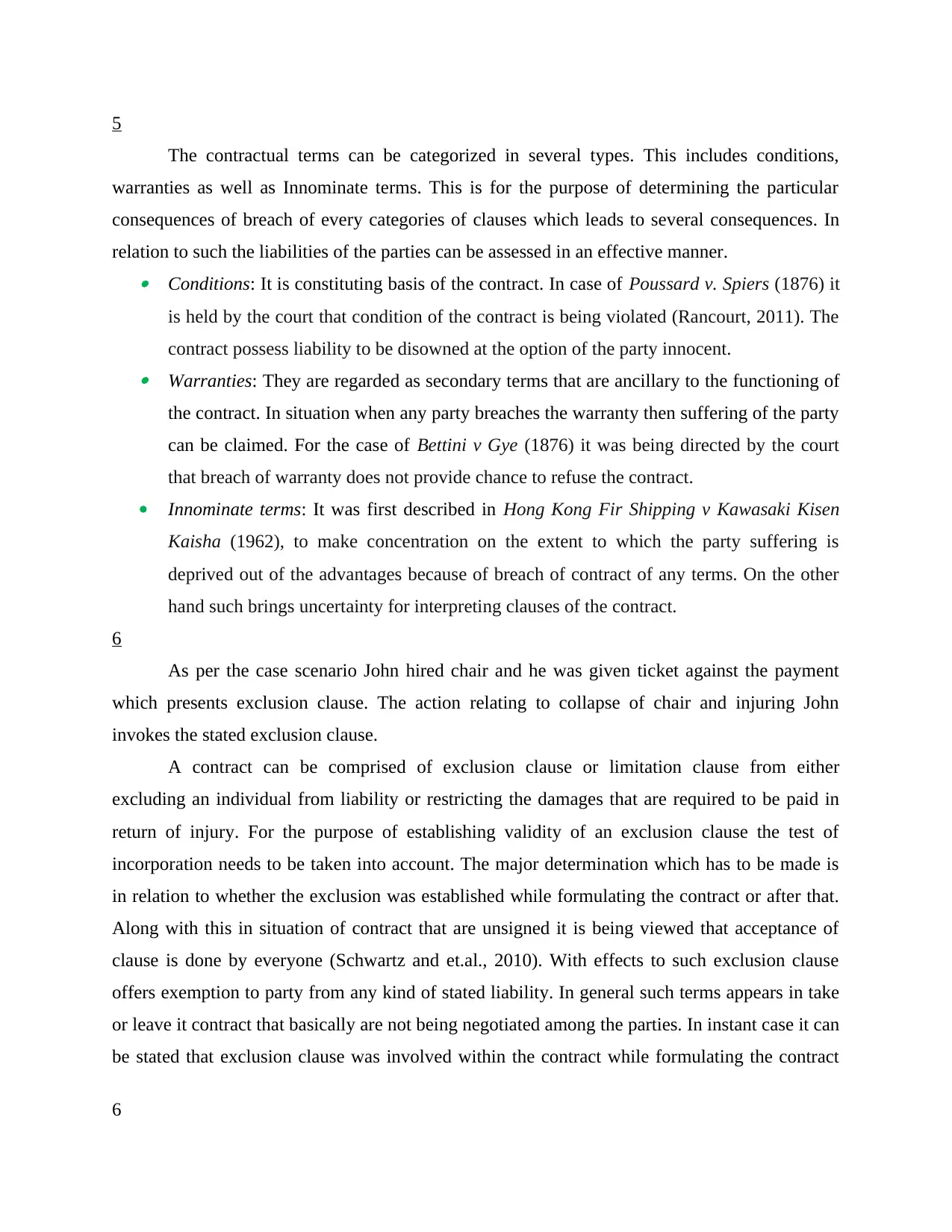
5
The contractual terms can be categorized in several types. This includes conditions,
warranties as well as Innominate terms. This is for the purpose of determining the particular
consequences of breach of every categories of clauses which leads to several consequences. In
relation to such the liabilities of the parties can be assessed in an effective manner. Conditions: It is constituting basis of the contract. In case of Poussard v. Spiers (1876) it
is held by the court that condition of the contract is being violated (Rancourt, 2011). The
contract possess liability to be disowned at the option of the party innocent. Warranties: They are regarded as secondary terms that are ancillary to the functioning of
the contract. In situation when any party breaches the warranty then suffering of the party
can be claimed. For the case of Bettini v Gye (1876) it was being directed by the court
that breach of warranty does not provide chance to refuse the contract.
Innominate terms: It was first described in Hong Kong Fir Shipping v Kawasaki Kisen
Kaisha (1962), to make concentration on the extent to which the party suffering is
deprived out of the advantages because of breach of contract of any terms. On the other
hand such brings uncertainty for interpreting clauses of the contract.
6
As per the case scenario John hired chair and he was given ticket against the payment
which presents exclusion clause. The action relating to collapse of chair and injuring John
invokes the stated exclusion clause.
A contract can be comprised of exclusion clause or limitation clause from either
excluding an individual from liability or restricting the damages that are required to be paid in
return of injury. For the purpose of establishing validity of an exclusion clause the test of
incorporation needs to be taken into account. The major determination which has to be made is
in relation to whether the exclusion was established while formulating the contract or after that.
Along with this in situation of contract that are unsigned it is being viewed that acceptance of
clause is done by everyone (Schwartz and et.al., 2010). With effects to such exclusion clause
offers exemption to party from any kind of stated liability. In general such terms appears in take
or leave it contract that basically are not being negotiated among the parties. In instant case it can
be stated that exclusion clause was involved within the contract while formulating the contract
6
The contractual terms can be categorized in several types. This includes conditions,
warranties as well as Innominate terms. This is for the purpose of determining the particular
consequences of breach of every categories of clauses which leads to several consequences. In
relation to such the liabilities of the parties can be assessed in an effective manner. Conditions: It is constituting basis of the contract. In case of Poussard v. Spiers (1876) it
is held by the court that condition of the contract is being violated (Rancourt, 2011). The
contract possess liability to be disowned at the option of the party innocent. Warranties: They are regarded as secondary terms that are ancillary to the functioning of
the contract. In situation when any party breaches the warranty then suffering of the party
can be claimed. For the case of Bettini v Gye (1876) it was being directed by the court
that breach of warranty does not provide chance to refuse the contract.
Innominate terms: It was first described in Hong Kong Fir Shipping v Kawasaki Kisen
Kaisha (1962), to make concentration on the extent to which the party suffering is
deprived out of the advantages because of breach of contract of any terms. On the other
hand such brings uncertainty for interpreting clauses of the contract.
6
As per the case scenario John hired chair and he was given ticket against the payment
which presents exclusion clause. The action relating to collapse of chair and injuring John
invokes the stated exclusion clause.
A contract can be comprised of exclusion clause or limitation clause from either
excluding an individual from liability or restricting the damages that are required to be paid in
return of injury. For the purpose of establishing validity of an exclusion clause the test of
incorporation needs to be taken into account. The major determination which has to be made is
in relation to whether the exclusion was established while formulating the contract or after that.
Along with this in situation of contract that are unsigned it is being viewed that acceptance of
clause is done by everyone (Schwartz and et.al., 2010). With effects to such exclusion clause
offers exemption to party from any kind of stated liability. In general such terms appears in take
or leave it contract that basically are not being negotiated among the parties. In instant case it can
be stated that exclusion clause was involved within the contract while formulating the contract
6
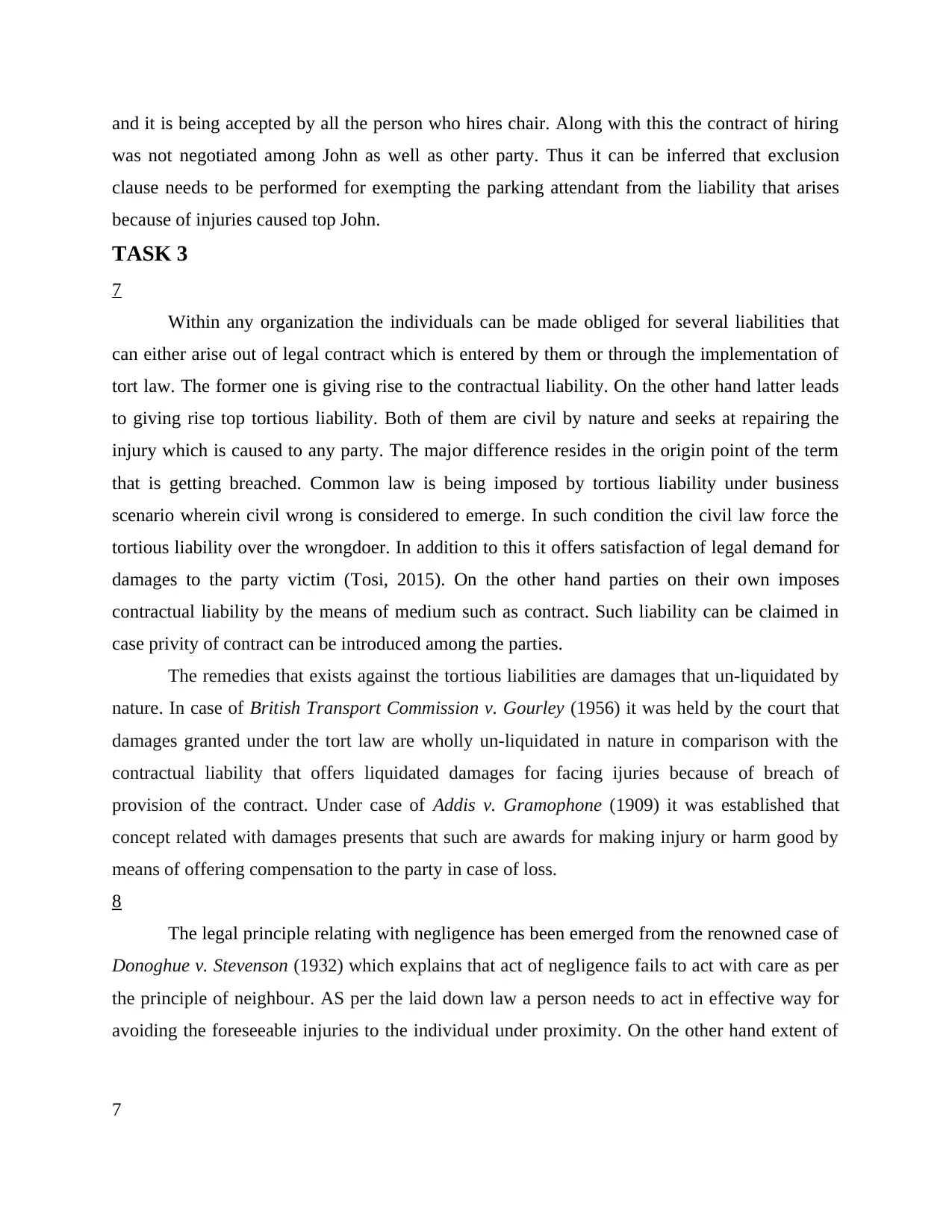
and it is being accepted by all the person who hires chair. Along with this the contract of hiring
was not negotiated among John as well as other party. Thus it can be inferred that exclusion
clause needs to be performed for exempting the parking attendant from the liability that arises
because of injuries caused top John.
TASK 3
7
Within any organization the individuals can be made obliged for several liabilities that
can either arise out of legal contract which is entered by them or through the implementation of
tort law. The former one is giving rise to the contractual liability. On the other hand latter leads
to giving rise top tortious liability. Both of them are civil by nature and seeks at repairing the
injury which is caused to any party. The major difference resides in the origin point of the term
that is getting breached. Common law is being imposed by tortious liability under business
scenario wherein civil wrong is considered to emerge. In such condition the civil law force the
tortious liability over the wrongdoer. In addition to this it offers satisfaction of legal demand for
damages to the party victim (Tosi, 2015). On the other hand parties on their own imposes
contractual liability by the means of medium such as contract. Such liability can be claimed in
case privity of contract can be introduced among the parties.
The remedies that exists against the tortious liabilities are damages that un-liquidated by
nature. In case of British Transport Commission v. Gourley (1956) it was held by the court that
damages granted under the tort law are wholly un-liquidated in nature in comparison with the
contractual liability that offers liquidated damages for facing ijuries because of breach of
provision of the contract. Under case of Addis v. Gramophone (1909) it was established that
concept related with damages presents that such are awards for making injury or harm good by
means of offering compensation to the party in case of loss.
8
The legal principle relating with negligence has been emerged from the renowned case of
Donoghue v. Stevenson (1932) which explains that act of negligence fails to act with care as per
the principle of neighbour. AS per the laid down law a person needs to act in effective way for
avoiding the foreseeable injuries to the individual under proximity. On the other hand extent of
7
was not negotiated among John as well as other party. Thus it can be inferred that exclusion
clause needs to be performed for exempting the parking attendant from the liability that arises
because of injuries caused top John.
TASK 3
7
Within any organization the individuals can be made obliged for several liabilities that
can either arise out of legal contract which is entered by them or through the implementation of
tort law. The former one is giving rise to the contractual liability. On the other hand latter leads
to giving rise top tortious liability. Both of them are civil by nature and seeks at repairing the
injury which is caused to any party. The major difference resides in the origin point of the term
that is getting breached. Common law is being imposed by tortious liability under business
scenario wherein civil wrong is considered to emerge. In such condition the civil law force the
tortious liability over the wrongdoer. In addition to this it offers satisfaction of legal demand for
damages to the party victim (Tosi, 2015). On the other hand parties on their own imposes
contractual liability by the means of medium such as contract. Such liability can be claimed in
case privity of contract can be introduced among the parties.
The remedies that exists against the tortious liabilities are damages that un-liquidated by
nature. In case of British Transport Commission v. Gourley (1956) it was held by the court that
damages granted under the tort law are wholly un-liquidated in nature in comparison with the
contractual liability that offers liquidated damages for facing ijuries because of breach of
provision of the contract. Under case of Addis v. Gramophone (1909) it was established that
concept related with damages presents that such are awards for making injury or harm good by
means of offering compensation to the party in case of loss.
8
The legal principle relating with negligence has been emerged from the renowned case of
Donoghue v. Stevenson (1932) which explains that act of negligence fails to act with care as per
the principle of neighbour. AS per the laid down law a person needs to act in effective way for
avoiding the foreseeable injuries to the individual under proximity. On the other hand extent of
7
Paraphrase This Document
Need a fresh take? Get an instant paraphrase of this document with our AI Paraphraser
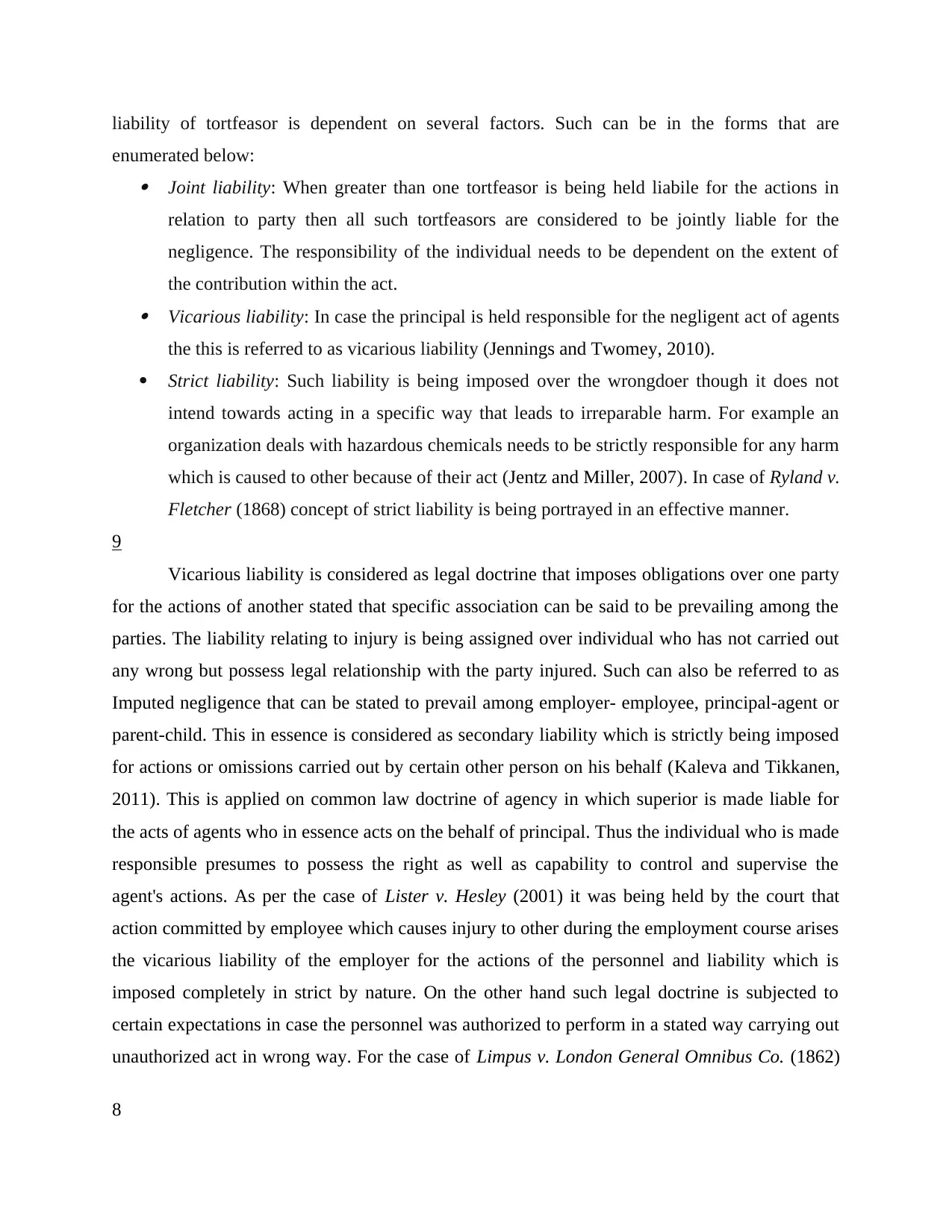
liability of tortfeasor is dependent on several factors. Such can be in the forms that are
enumerated below: Joint liability: When greater than one tortfeasor is being held liabile for the actions in
relation to party then all such tortfeasors are considered to be jointly liable for the
negligence. The responsibility of the individual needs to be dependent on the extent of
the contribution within the act. Vicarious liability: In case the principal is held responsible for the negligent act of agents
the this is referred to as vicarious liability (Jennings and Twomey, 2010).
Strict liability: Such liability is being imposed over the wrongdoer though it does not
intend towards acting in a specific way that leads to irreparable harm. For example an
organization deals with hazardous chemicals needs to be strictly responsible for any harm
which is caused to other because of their act (Jentz and Miller, 2007). In case of Ryland v.
Fletcher (1868) concept of strict liability is being portrayed in an effective manner.
9
Vicarious liability is considered as legal doctrine that imposes obligations over one party
for the actions of another stated that specific association can be said to be prevailing among the
parties. The liability relating to injury is being assigned over individual who has not carried out
any wrong but possess legal relationship with the party injured. Such can also be referred to as
Imputed negligence that can be stated to prevail among employer- employee, principal-agent or
parent-child. This in essence is considered as secondary liability which is strictly being imposed
for actions or omissions carried out by certain other person on his behalf (Kaleva and Tikkanen,
2011). This is applied on common law doctrine of agency in which superior is made liable for
the acts of agents who in essence acts on the behalf of principal. Thus the individual who is made
responsible presumes to possess the right as well as capability to control and supervise the
agent's actions. As per the case of Lister v. Hesley (2001) it was being held by the court that
action committed by employee which causes injury to other during the employment course arises
the vicarious liability of the employer for the actions of the personnel and liability which is
imposed completely in strict by nature. On the other hand such legal doctrine is subjected to
certain expectations in case the personnel was authorized to perform in a stated way carrying out
unauthorized act in wrong way. For the case of Limpus v. London General Omnibus Co. (1862)
8
enumerated below: Joint liability: When greater than one tortfeasor is being held liabile for the actions in
relation to party then all such tortfeasors are considered to be jointly liable for the
negligence. The responsibility of the individual needs to be dependent on the extent of
the contribution within the act. Vicarious liability: In case the principal is held responsible for the negligent act of agents
the this is referred to as vicarious liability (Jennings and Twomey, 2010).
Strict liability: Such liability is being imposed over the wrongdoer though it does not
intend towards acting in a specific way that leads to irreparable harm. For example an
organization deals with hazardous chemicals needs to be strictly responsible for any harm
which is caused to other because of their act (Jentz and Miller, 2007). In case of Ryland v.
Fletcher (1868) concept of strict liability is being portrayed in an effective manner.
9
Vicarious liability is considered as legal doctrine that imposes obligations over one party
for the actions of another stated that specific association can be said to be prevailing among the
parties. The liability relating to injury is being assigned over individual who has not carried out
any wrong but possess legal relationship with the party injured. Such can also be referred to as
Imputed negligence that can be stated to prevail among employer- employee, principal-agent or
parent-child. This in essence is considered as secondary liability which is strictly being imposed
for actions or omissions carried out by certain other person on his behalf (Kaleva and Tikkanen,
2011). This is applied on common law doctrine of agency in which superior is made liable for
the acts of agents who in essence acts on the behalf of principal. Thus the individual who is made
responsible presumes to possess the right as well as capability to control and supervise the
agent's actions. As per the case of Lister v. Hesley (2001) it was being held by the court that
action committed by employee which causes injury to other during the employment course arises
the vicarious liability of the employer for the actions of the personnel and liability which is
imposed completely in strict by nature. On the other hand such legal doctrine is subjected to
certain expectations in case the personnel was authorized to perform in a stated way carrying out
unauthorized act in wrong way. For the case of Limpus v. London General Omnibus Co. (1862)
8
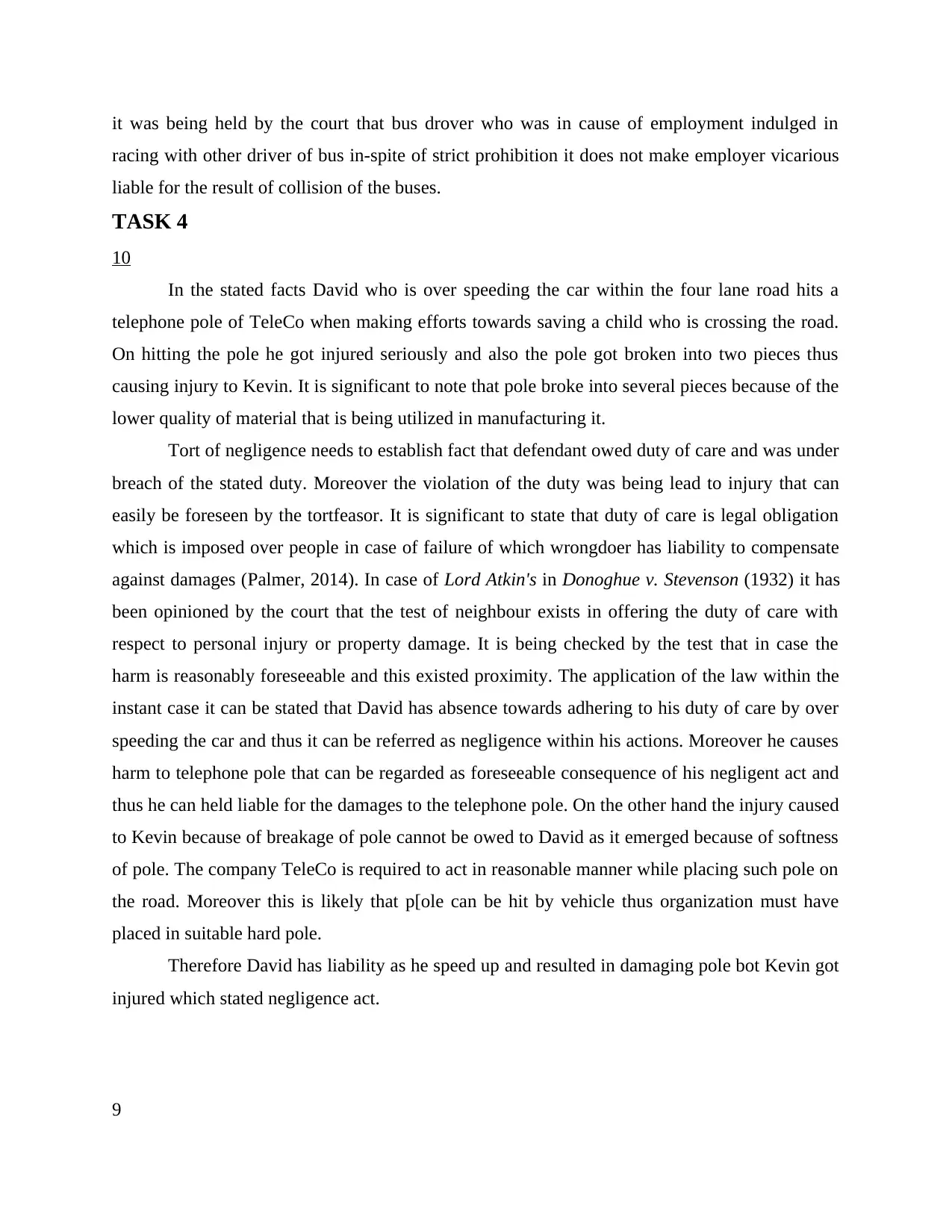
it was being held by the court that bus drover who was in cause of employment indulged in
racing with other driver of bus in-spite of strict prohibition it does not make employer vicarious
liable for the result of collision of the buses.
TASK 4
10
In the stated facts David who is over speeding the car within the four lane road hits a
telephone pole of TeleCo when making efforts towards saving a child who is crossing the road.
On hitting the pole he got injured seriously and also the pole got broken into two pieces thus
causing injury to Kevin. It is significant to note that pole broke into several pieces because of the
lower quality of material that is being utilized in manufacturing it.
Tort of negligence needs to establish fact that defendant owed duty of care and was under
breach of the stated duty. Moreover the violation of the duty was being lead to injury that can
easily be foreseen by the tortfeasor. It is significant to state that duty of care is legal obligation
which is imposed over people in case of failure of which wrongdoer has liability to compensate
against damages (Palmer, 2014). In case of Lord Atkin's in Donoghue v. Stevenson (1932) it has
been opinioned by the court that the test of neighbour exists in offering the duty of care with
respect to personal injury or property damage. It is being checked by the test that in case the
harm is reasonably foreseeable and this existed proximity. The application of the law within the
instant case it can be stated that David has absence towards adhering to his duty of care by over
speeding the car and thus it can be referred as negligence within his actions. Moreover he causes
harm to telephone pole that can be regarded as foreseeable consequence of his negligent act and
thus he can held liable for the damages to the telephone pole. On the other hand the injury caused
to Kevin because of breakage of pole cannot be owed to David as it emerged because of softness
of pole. The company TeleCo is required to act in reasonable manner while placing such pole on
the road. Moreover this is likely that p[ole can be hit by vehicle thus organization must have
placed in suitable hard pole.
Therefore David has liability as he speed up and resulted in damaging pole bot Kevin got
injured which stated negligence act.
9
racing with other driver of bus in-spite of strict prohibition it does not make employer vicarious
liable for the result of collision of the buses.
TASK 4
10
In the stated facts David who is over speeding the car within the four lane road hits a
telephone pole of TeleCo when making efforts towards saving a child who is crossing the road.
On hitting the pole he got injured seriously and also the pole got broken into two pieces thus
causing injury to Kevin. It is significant to note that pole broke into several pieces because of the
lower quality of material that is being utilized in manufacturing it.
Tort of negligence needs to establish fact that defendant owed duty of care and was under
breach of the stated duty. Moreover the violation of the duty was being lead to injury that can
easily be foreseen by the tortfeasor. It is significant to state that duty of care is legal obligation
which is imposed over people in case of failure of which wrongdoer has liability to compensate
against damages (Palmer, 2014). In case of Lord Atkin's in Donoghue v. Stevenson (1932) it has
been opinioned by the court that the test of neighbour exists in offering the duty of care with
respect to personal injury or property damage. It is being checked by the test that in case the
harm is reasonably foreseeable and this existed proximity. The application of the law within the
instant case it can be stated that David has absence towards adhering to his duty of care by over
speeding the car and thus it can be referred as negligence within his actions. Moreover he causes
harm to telephone pole that can be regarded as foreseeable consequence of his negligent act and
thus he can held liable for the damages to the telephone pole. On the other hand the injury caused
to Kevin because of breakage of pole cannot be owed to David as it emerged because of softness
of pole. The company TeleCo is required to act in reasonable manner while placing such pole on
the road. Moreover this is likely that p[ole can be hit by vehicle thus organization must have
placed in suitable hard pole.
Therefore David has liability as he speed up and resulted in damaging pole bot Kevin got
injured which stated negligence act.
9
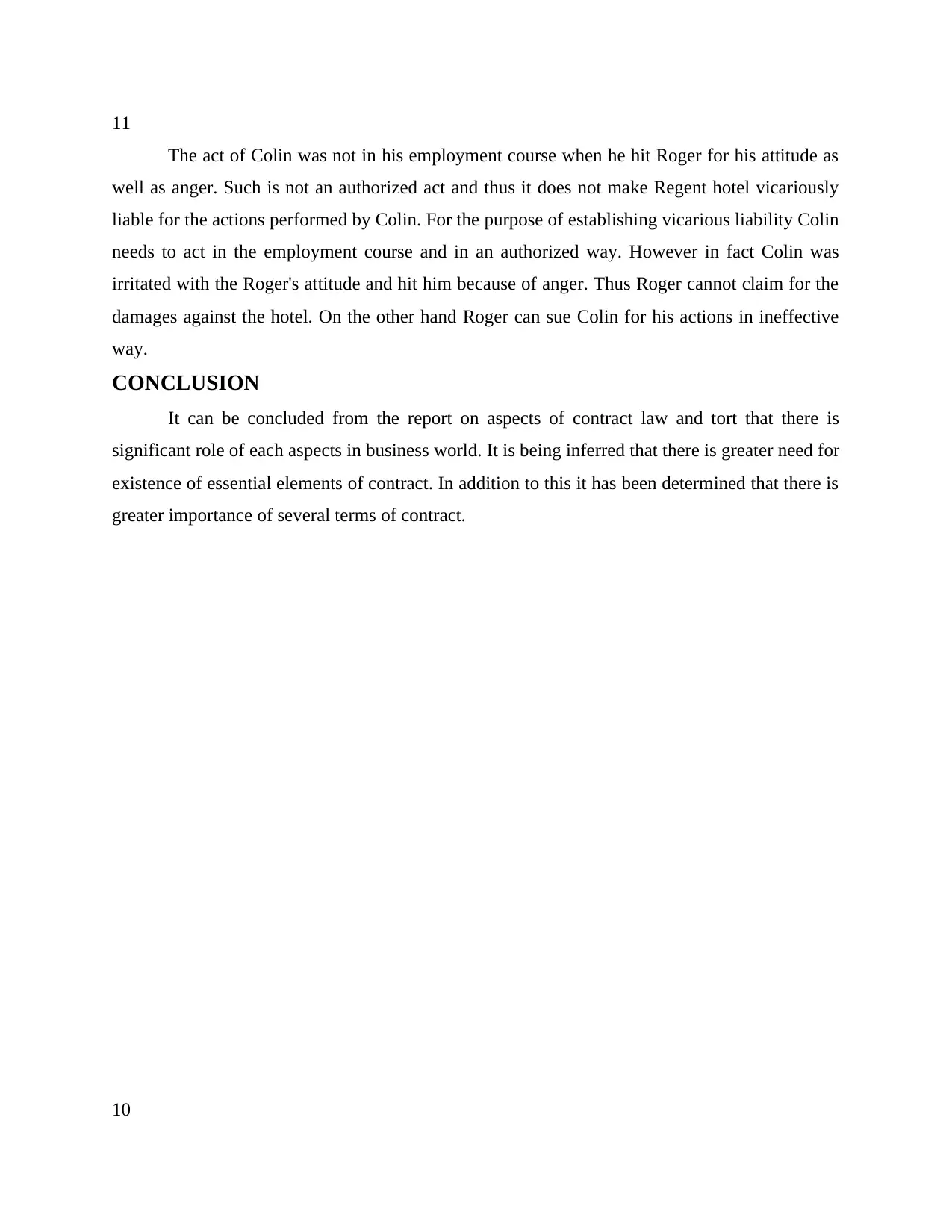
11
The act of Colin was not in his employment course when he hit Roger for his attitude as
well as anger. Such is not an authorized act and thus it does not make Regent hotel vicariously
liable for the actions performed by Colin. For the purpose of establishing vicarious liability Colin
needs to act in the employment course and in an authorized way. However in fact Colin was
irritated with the Roger's attitude and hit him because of anger. Thus Roger cannot claim for the
damages against the hotel. On the other hand Roger can sue Colin for his actions in ineffective
way.
CONCLUSION
It can be concluded from the report on aspects of contract law and tort that there is
significant role of each aspects in business world. It is being inferred that there is greater need for
existence of essential elements of contract. In addition to this it has been determined that there is
greater importance of several terms of contract.
10
The act of Colin was not in his employment course when he hit Roger for his attitude as
well as anger. Such is not an authorized act and thus it does not make Regent hotel vicariously
liable for the actions performed by Colin. For the purpose of establishing vicarious liability Colin
needs to act in the employment course and in an authorized way. However in fact Colin was
irritated with the Roger's attitude and hit him because of anger. Thus Roger cannot claim for the
damages against the hotel. On the other hand Roger can sue Colin for his actions in ineffective
way.
CONCLUSION
It can be concluded from the report on aspects of contract law and tort that there is
significant role of each aspects in business world. It is being inferred that there is greater need for
existence of essential elements of contract. In addition to this it has been determined that there is
greater importance of several terms of contract.
10
Secure Best Marks with AI Grader
Need help grading? Try our AI Grader for instant feedback on your assignments.
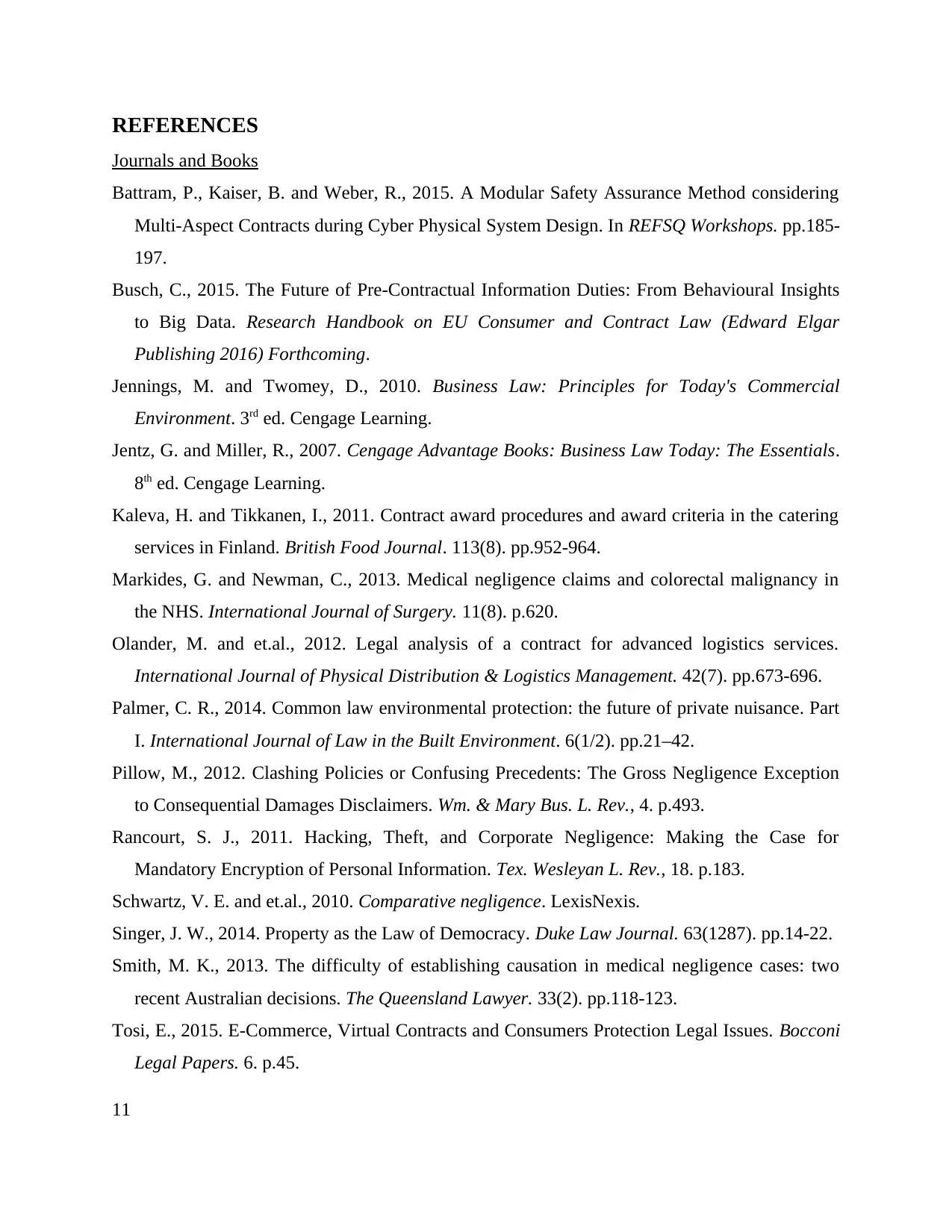
REFERENCES
Journals and Books
Battram, P., Kaiser, B. and Weber, R., 2015. A Modular Safety Assurance Method considering
Multi-Aspect Contracts during Cyber Physical System Design. In REFSQ Workshops. pp.185-
197.
Busch, C., 2015. The Future of Pre-Contractual Information Duties: From Behavioural Insights
to Big Data. Research Handbook on EU Consumer and Contract Law (Edward Elgar
Publishing 2016) Forthcoming.
Jennings, M. and Twomey, D., 2010. Business Law: Principles for Today's Commercial
Environment. 3rd ed. Cengage Learning.
Jentz, G. and Miller, R., 2007. Cengage Advantage Books: Business Law Today: The Essentials.
8th ed. Cengage Learning.
Kaleva, H. and Tikkanen, I., 2011. Contract award procedures and award criteria in the catering
services in Finland. British Food Journal. 113(8). pp.952-964.
Markides, G. and Newman, C., 2013. Medical negligence claims and colorectal malignancy in
the NHS. International Journal of Surgery. 11(8). p.620.
Olander, M. and et.al., 2012. Legal analysis of a contract for advanced logistics services.
International Journal of Physical Distribution & Logistics Management. 42(7). pp.673-696.
Palmer, C. R., 2014. Common law environmental protection: the future of private nuisance. Part
I. International Journal of Law in the Built Environment. 6(1/2). pp.21–42.
Pillow, M., 2012. Clashing Policies or Confusing Precedents: The Gross Negligence Exception
to Consequential Damages Disclaimers. Wm. & Mary Bus. L. Rev., 4. p.493.
Rancourt, S. J., 2011. Hacking, Theft, and Corporate Negligence: Making the Case for
Mandatory Encryption of Personal Information. Tex. Wesleyan L. Rev., 18. p.183.
Schwartz, V. E. and et.al., 2010. Comparative negligence. LexisNexis.
Singer, J. W., 2014. Property as the Law of Democracy. Duke Law Journal. 63(1287). pp.14-22.
Smith, M. K., 2013. The difficulty of establishing causation in medical negligence cases: two
recent Australian decisions. The Queensland Lawyer. 33(2). pp.118-123.
Tosi, E., 2015. E-Commerce, Virtual Contracts and Consumers Protection Legal Issues. Bocconi
Legal Papers. 6. p.45.
11
Journals and Books
Battram, P., Kaiser, B. and Weber, R., 2015. A Modular Safety Assurance Method considering
Multi-Aspect Contracts during Cyber Physical System Design. In REFSQ Workshops. pp.185-
197.
Busch, C., 2015. The Future of Pre-Contractual Information Duties: From Behavioural Insights
to Big Data. Research Handbook on EU Consumer and Contract Law (Edward Elgar
Publishing 2016) Forthcoming.
Jennings, M. and Twomey, D., 2010. Business Law: Principles for Today's Commercial
Environment. 3rd ed. Cengage Learning.
Jentz, G. and Miller, R., 2007. Cengage Advantage Books: Business Law Today: The Essentials.
8th ed. Cengage Learning.
Kaleva, H. and Tikkanen, I., 2011. Contract award procedures and award criteria in the catering
services in Finland. British Food Journal. 113(8). pp.952-964.
Markides, G. and Newman, C., 2013. Medical negligence claims and colorectal malignancy in
the NHS. International Journal of Surgery. 11(8). p.620.
Olander, M. and et.al., 2012. Legal analysis of a contract for advanced logistics services.
International Journal of Physical Distribution & Logistics Management. 42(7). pp.673-696.
Palmer, C. R., 2014. Common law environmental protection: the future of private nuisance. Part
I. International Journal of Law in the Built Environment. 6(1/2). pp.21–42.
Pillow, M., 2012. Clashing Policies or Confusing Precedents: The Gross Negligence Exception
to Consequential Damages Disclaimers. Wm. & Mary Bus. L. Rev., 4. p.493.
Rancourt, S. J., 2011. Hacking, Theft, and Corporate Negligence: Making the Case for
Mandatory Encryption of Personal Information. Tex. Wesleyan L. Rev., 18. p.183.
Schwartz, V. E. and et.al., 2010. Comparative negligence. LexisNexis.
Singer, J. W., 2014. Property as the Law of Democracy. Duke Law Journal. 63(1287). pp.14-22.
Smith, M. K., 2013. The difficulty of establishing causation in medical negligence cases: two
recent Australian decisions. The Queensland Lawyer. 33(2). pp.118-123.
Tosi, E., 2015. E-Commerce, Virtual Contracts and Consumers Protection Legal Issues. Bocconi
Legal Papers. 6. p.45.
11
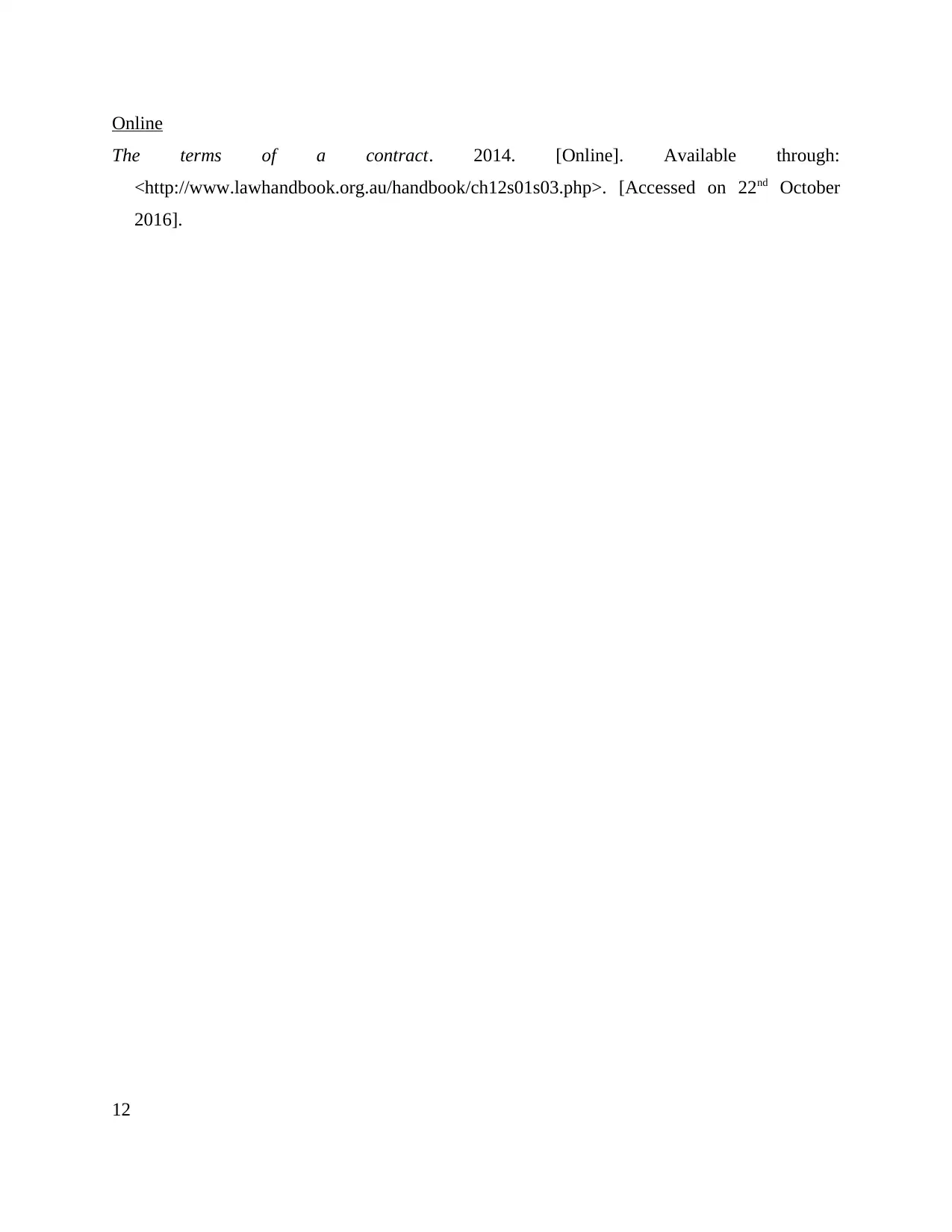
Online
The terms of a contract. 2014. [Online]. Available through:
<http://www.lawhandbook.org.au/handbook/ch12s01s03.php>. [Accessed on 22nd October
2016].
12
The terms of a contract. 2014. [Online]. Available through:
<http://www.lawhandbook.org.au/handbook/ch12s01s03.php>. [Accessed on 22nd October
2016].
12
1 out of 12
Related Documents
Your All-in-One AI-Powered Toolkit for Academic Success.
+13062052269
info@desklib.com
Available 24*7 on WhatsApp / Email
![[object Object]](/_next/static/media/star-bottom.7253800d.svg)
Unlock your academic potential
© 2024 | Zucol Services PVT LTD | All rights reserved.




